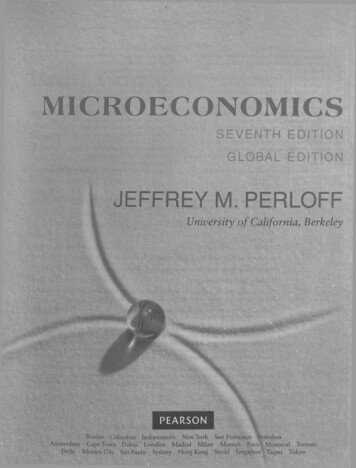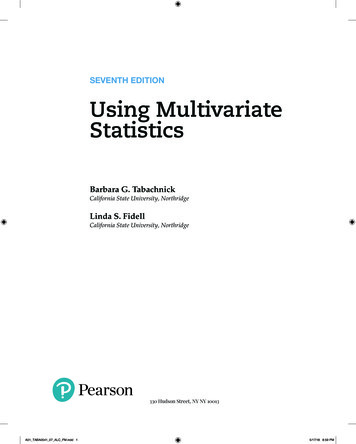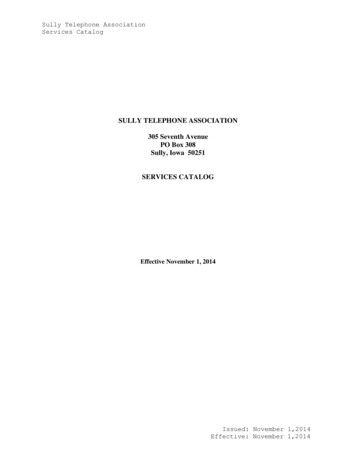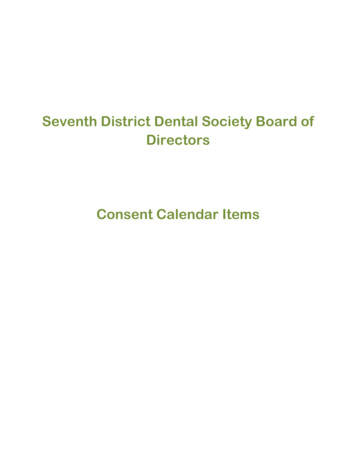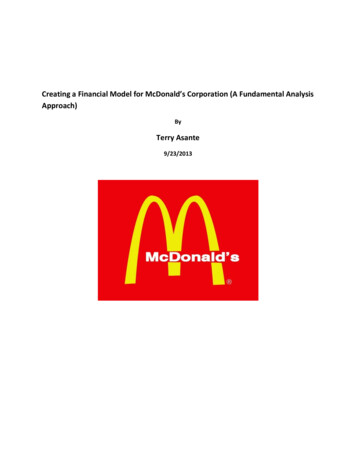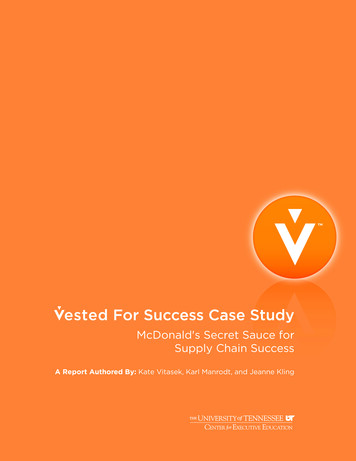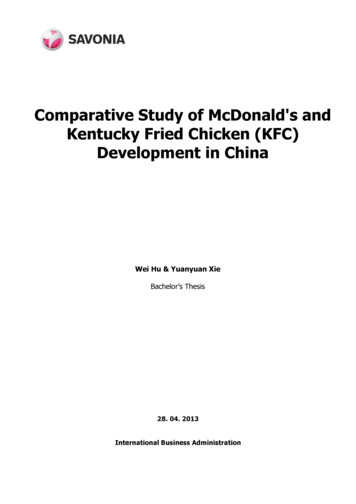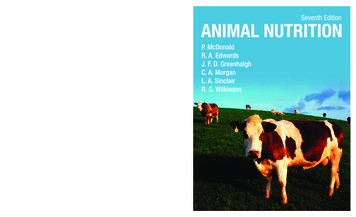
Transcription
Seventh EditionP. McDonald R. A. Edwards J. F. D. GreenhalghC. A. Morgan L. A. Sinclair R. G. WilkinsonAnimal Nutrition is a core text for undergraduates in Animal Science, Veterinary Science, Agriculture,Biology and Biochemistry studying this subject. It also provides a standard reference text for agriculturaladvisers, animal nutritionists and manufacturers of animal feeds.The latest edition of this classic text continues to provide a clear and comprehensive introduction to thescience and practice of animal nutrition. The text is supported by key experimental evidence throughout.Quantitative aspects of the subject are clearly explained and illustrated by worked examples. Chaptersthat deal with the calculation of requirements include problems and solutions to aid student learning. Otherchapters include essay-type questions that students can use as a guide to revision.The new edition of Animal Nutrition has been completely updated and has been reorganised topresent the subject in six sections:the components of foods – carbohydrates, lipids, proteins, vitamins and minerals the digestion and metabolism of nutrients – how animals obtain and utilise nutrients from foods quantifying the nutrients supplied by foods – digestibility, energy and protein values the nutrient requirements of animals – maintenance and production a description of the foods commonly given to animals – their nutrient content and factorsaffecting their use the contribution of animal products to human nutrition – including effects on health and theenvironmentThe Appendix provides comprehensive tables on the composition of foods and the latest feedingstandards for dairy and beef cattle, sheep, pigs and poultry, and horses.P McDonald was formerly Head of the Department of Agricultural Biochemistry at the Edinburgh Schoolof Agriculture. R A Edwards was formerly Head of the Department of Animal Nutrition at the EdinburghSchool of Agriculture. J F D Greenhalgh is Emeritus Professor of Animal Production and Health atthe University of Aberdeen. C A Morgan is an animal nutritionist at the Scottish Agricultural College,Edinburgh. L A Sinclair is Professor of Animal Science at Harper Adams University College. R G Wilkinsonis Principal Lecturer in Ruminant Nutrition at Harper Adams University CollegeFront cover image: Getty ImagesCVR MCDO4238 07 SE CVR.indd 1Seventh EditionAnimal NutritionP. McDonaldR. A. EdwardsJ. F. D. GreenhalghC. A. MorganL. A. SinclairR. G. WilkinsonMcDonald Edwards GreenhalghMorgan Sinclair Wilkinson Animal NutritionAnimal 2010 15:00
ANIMAL NUTRITION
We work with leading authors to develop the strongesteducational materials in biology, bringing cutting-edgethinking and best learning practice to a global market.Under a range of well-known imprints, includingPrentice Hall, we craft high-quality print and electronicpublications which help readers to understand and applytheir content, whether studying or at work.To find out more about the complete range of ourpublishing, please visit us on the World Wide Web at:www.pearsoned.co.uk
ANIMAL NUTRITIONSEVENTH EDITIONP McDonaldFormerly Reader in Agricultural Biochemistry, University ofEdinburgh, and Head of the Department of AgriculturalBiochemistry, Edinburgh School of AgricultureR A EdwardsFormerly Head of the Department of Animal Nutrition,Edinburgh School of AgricultureJ F D GreenhalghEmeritus Professor of Animal Production and Health,University of AberdeenC A MorganScottish Agricultural CollegeL A SinclairHarper Adams University CollegeR G WilkinsonHarper Adams University College
ContentsPreface to the seventh editionAcknowledgementsPart 1THE COMPONENTS OF FOODS1 The animal and its food1.1 Water1.2 Dry matter and its components1.3 Analysis and characterisation of foodsSummaryFurther reading2 Carbohydrates2.12.22.32.42.52.6Classification of carbohydratesMonosaccharidesMonosaccharide mmaryFurther readingxixii1345514151616182023263030313 lassification of penesSummaryQuestionsFurther reading4 Proteins, nucleic acids and other nitrogenous compounds4.14.24.34.44.54.64.7ProteinsAmino acidsPeptidesStructure of proteinsProperties of proteinsClassification of proteinsNucleic acids5353535960616163v
Contents4.8 Other nitrogenous compounds4.9 Nitrates4.10 AlkaloidsSummaryFurther reading5 Vitamins5.15.25.35.45.5IntroductionFat-soluble vitaminsThe vitamin B complexVitamin CHypervitaminosisSummaryFurther reading6 Minerals6.16.26.36.46.56.6Functions of mineralsNatural and supplementary sources of mineralsAcid–base balanceMajor elementsTrace elementsOther elementsSummaryFurther readingPart 2THE DIGESTION AND METABOLISM OF NUTRIENTS7 Enzymes7.17.27.37.47.57.6Classification of enzymesNature of enzymesMechanism of enzyme actionSpecific nature of enzymesFactors affecting enzyme activityNomenclature of enzymesSummaryFurther reading8 Digestion8.18.28.38.4Digestion in monogastric mammalsMicrobial digestion in ruminants and other herbivoresAlternative sites of microbial digestionNutrient digestion and the environmentSummaryFurther readingHistorical reference9 Metabolism9.1 Energy metabolism9.2 Protein 156171186188189191191192194213
Contents9.3 Fat synthesis9.4 Carbohydrate synthesis9.5 Control of metabolismSummaryFurther reading219226232233234Part 3QUANTIFYING THE NUTRIENT CONTENT OF FOODS:DIGESTIBILITY, ENERGY AND PROTEIN VALUES23510 Evaluation of foods: digestibility23710.110.210.310.410.5Measurement of digestibilityValidity of digestibility coefficientsDigestibility in different sections of the digestive tractFactors affecting digestibilityMeasurement of mineral availabilitySummaryQuestionsFurther reading11 Evaluation of foods: energy content of foodsand energy partition within the animal11.1 Demand for energy11.2 Supply of energy11.3 Animal calorimetry: methods for measuring heat productionand energy retention11.4 Utilisation of metabolisable energySummaryQuestionsFurther reading12 Evaluation of foods: systems for expressingthe energy value of foods12.112.212.312.412.5Energy systems and energy modelsEnergy systems for ruminantsEnergy systems for pigs and poultryEnergy systems for horsesPredicting the energy value of foodsSummaryQuestionsFurther readingHistorical references13 Evaluation of foods: protein13.113.213.313.413.5Crude proteinDigestible crude proteinDetermination of endogenous nitrogenMeasures of protein quality for monogastric animalsMeasures of food protein used in practice in the feedingof pigs and 315vii
Contents13.613.713.813.9Measures of food protein used in practice in the feeding of horsesMeasures of protein quality for ruminant animalsThe UK metabolisable protein systemFeed into MilkSummaryQuestionsFurther readingPart 4THE NUTRIENT REQUIREMENTS OF ANIMALS34114 Feeding standards for maintenance and growth34314.114.214.314.4Nutrient requirements for maintenanceNutrient requirements for growthNutrient requirements for wool productionMineral and vitamin requirements for maintenanceand growth14.5 Nutritional control of growthSummaryQuestionsFurther readingHistorical reference15 Feeding standards for reproduction15.115.215.315.4Nutrition and the initiation of reproductive abilityPlane of nutrition, fertility and fecundityEgg production in poultryNutrition and the growth of the foetusSummaryQuestionsFurther reading16 Lactation16.116.216.316.416.516.6Sources of milk constituentsNutrient requirements of the lactating dairy cowNutrient requirements of the lactating goatNutrient requirements of the lactating eweNutrient requirements of the lactating sowNutrient requirements of the lactating mareSummaryQuestionsFurther reading17 Voluntary intake of food17.1 Food intake in monogastric animals17.2 Food intake in ruminants17.3 Food intake in 453457458459461462468474
Contents17.4 Prediction of food intakeSummaryQuestionsFurther reading474476477477Part 5THE NUTRITIONAL CHARACTERISTICS OF FOODS47918 Grass and forage crops48118.118.218.318.4Pastures and grazing animalsGrassesLegumesOther foragesSummaryQuestionsFurther reading19 Silage19.119.219.319.419.519.619.7Silage, ensilage and silosRole of plant enzymes in ensilageRole of microorganisms in ensilageNutrient losses in ensilageClassification of silagesNutritive value of silagesWhole crop cereal and legume silagesSummaryQuestionsFurther reading20 Hay, artificially dried forages, straws and chaff20.1 Hay20.2 Artificially dried forages20.3 Straws and related by-productsSummaryQuestionsFurther reading21 Roots, tubers and related by-products21.1 Roots21.2 TubersSummaryQuestionsFurther 22 Cereal grains and cereal by-products54122.1 The nutrient composition of grains22.2 Barley22.3 Maize541543551ix
Contents22.422.522.622.7OatsWheatOther cerealsCereal processingSummaryQuestionsFurther reading23 Protein d cakes and mealsOilseed residues of minor importanceLeguminous seedsAnimal protein concentratesMilk productsSingle-cell proteinSynthetic amino acidsNon-protein nitrogen compounds as protein sourcesSummaryQuestionsFurther reading24 Food obioticsOligosaccharidesEnzymesOrganic acidsSpray-dried plasmaModifiers of rumen fermentationSummaryQuestionsFurther 96599600602604605606607607Part 6ANIMAL PRODUCTS AND HUMAN NUTRITION60925 Animal nutrition and the consumers of animal products61125.125.225.325.4Comparative nutritionThe contribution of animal products to human requirementsObjections to the use of animal productsFuture trends in the consumption of animal productsSummaryQuestionsFurther readingAppendix 1: Solutions to numerical questionsAppendix 2: Notes on 3623625631665
Preface to the seventh editionThe science of animal nutrition continues to advance and this has necessitated, tovarying degrees, the updating of most chapters. In particular the new developmentsin dairy cow nutrition in the Feed into Milk System and the new nutrient requirements of pigs proposed by the British Society of Animal Science have been incorporated in the middle chapters and the Appendix tables. In addition newinformation, published in recent reviews of nutrient requirements by the NationalResearch Council of the United States, and the Commonwealth Scientific and Industrial Research Organisation of Australia has been included.The emphasis of research has shifted during the lifetime of the seven editions ofthis book from mainly outcomes and the effects of nutrition on the whole animal inthe earlier editions to mechanisms, both at a tissue and organ level and increasinglyat a molecular level.The authors are mindful of the need to extend the text in this direction and have included reference to developments in this area.For this edition Alun Edwards decided he would step down and we wish him well.The two remaining authors felt that, in view of the extent of revision required to incorporate the new information, new authors would be required to replace Peter McDonaldand Alun Edwards. Therefore, Liam Sinclair and Robert Wilkinson, Professor ofAnimal Science and Principal Lecturer in Ruminant Nutrition, respectively, of HarperAdams University College were invited to join the team. These new authors contribute a broad knowledge of animal nutrition and will ensure that the book can goto further editions.In this edition we have attempted to address comments and suggestions made byreviewers in order to improve the book. The subject matter is constantly changingand the authors welcome comments and feedback from readers so that the book canremain relevant and useful.Reviewing the book involved many discussions with colleagues and the authorsare grateful for their constructive comments, suggestions and support.C A Morgan, J F D Greenhalgh, L A Sinclair and R G WilkinsonAugust 2010xi
AcknowledgementsWe are grateful to the following for permission to reproduce copyright material:FiguresFigure 1.1 after Response in the Yield of Milk Constituents to the Intake of Nutrientsby Dairy Cows. AFRC Technical Committee on Responses to Nutrients, ReportNo. 11, CABI Publishing International,Wallingford (1998); Figure 5.1 adapted fromRoche Vitec Animal Nutrition and Vitamin News, Vol. 1, A1-10/2 (1984); Figure 5.4after Effects of vitamin E and selenium on the performance and immune status ofewes and lambs, Journal of Agricultural Science, 142:3, pp. 253–262 (Rooke J A,Robinson J J and Arthur J R 2004), The Nutrition Society, published byCambridge University Press, reproduced by permission of the publisher and the author;Figure 6.1 from Quantitative Aspects of Ruminant Digestion and Metabolism, 2nded., CAB International,Wallingford (eds Forbes J M and France J 1993) p. 481; Figure7.7 after mechanisms related to enzyme catalysis, Advances in Enzymology andRelated Areas of Molecular Biology, 24, p. 464 (Westheimer, F H 1962); Figures 8.1,8.2 after The Comparative Nutrition of Fowl and Swine: The Gastrointestinal Systems, Office for Educational Practice, University of Guelph (Moran E T Jr 1982); Figure 8.3 after Comparative physiology of the digestive system, Dukes’ Physiology ofDomestic Animals, 9th ed., pp. 216–232. ((ed.) Swenson, Melvin J. 1977), Copyright1933 by H H Dukes; Copyright 1977 by Cornell University. Used by permissionof the publisher, Cornell University Press; Figure 8.4 after Feeding and Care of theHorse, Lea & Febiger (Lewis, Lon 1982), reproduced with permission of John Wiley& Sons Inc.; Figure 8.5 after Metabolism in the Rumen, Methuen & Co. (Annison E Fand Lewis D 1959) p. 14; Figure 10.1 adapted from Comparison of two in vitroprocedures using rumen liquor-pepsin or pepsin-cellulase for prediction of foragedigestibility, Grass and Forage Science: Journal of the British Grassland Society,33 (1), pp. 13–18 (Terry R A, Mundell D C and Osbourn D F 1978); Figure 10.2adapted from A study of artificial fibre bag technique for determining the digestibility of feeds in the rumen, Journal of Agricultural Science, 88, pp. 645–650 (MehrezA Z and Ørskov E R 1977), Cambridge University Press, reproduced with permission of the publisher and the author; Figure 12.1 from Feed into Milk: A New AppliedFeeding System for Dairy Cows, Nottingham University Press (Ed.Thomas C 2004);Figure 12.2 adapted from Comparison of energy evaluation systems for dairy cowfeeds, Livestock Production Science, 51, pp. 255–266 (Kaustell K, Tuori M andHuhtanen P 1997), with permission from Elsevier; Figure 12.3 from Comparison ofenergy evaluation systems and a mechanistic model for milk production by dairy cattleoffered fresh grass-based diets, Animal Feed Science and Technology, 143, pp. 203–219(Dijksra J et al. 2008), with permission from Elsevier; Figure 13.4 from Chalupa Wand Sniffen C J, Carbohydrate, protein and amino acid nutrition of lactating dairyxii
Acknowledgementscattle, Recent Advances in Animal Nutrition, pp. 265–74 (eds. Garnsworthy P C,Cole D J A 1994); Figure 16.4 after The Energy Metabolism of Ruminants, Hutchinson(Blaxter K L 1967) p. 259 reproduced by permission of the publisher and the author;Figure 16.7 adapted from A review of the potential of nutrition to modify milk fatand protein, Livestock Production Science 23 (3–4), pp. 219–237 (Sutton J D andMorant S V 1989), with permission from Elsevier; Figure 16.8 adapted from Updateon theories of diet-induced milk fat depression and potential applications, RecentAdvances in Animal Nutrition, pp. 115–55 (Griinari J M and Bauman D E 2003);Figure 16.10 from The growth of lambs before and after birth in relation to the levelof nutrition, Journal of Agricultural Science, 38 (2), pp. 93–153 (Wallace R L 1948), Cambridge University Press, reproduced with permission of the publisher andthe author; Figure 16.11 adapted from The yield and composition of the milk ofFinnish Landrace Blackface ewes: I. Ewes and lambs maintained indoors, Journal ofAgricultural Science, 79 (2), pp. 303–313 (Peart J N, Edwards R A and Donaldson E1972), Cambridge University Press, reproduced with permission of the publisherand the author; Figure 16.13 after Variations in the chemical composition of milkwith particular reference to the solids-not-fat: I.The effect of stage of lactation, season ofyear and age of cow, Journal of Dairy Research, 23 (1), pp. 65–81 (Waite R,White J C Dand Robertson A 1956), Proprietors of Journal of Dairy Research, published byCambridge University Press, reproduced with permission of the publisher and theJournal of Dairy Research; Figure 17.2 after The effect of lactation on intake in thedairy cow, Proceedings, New Zealand Society for Animal Production, 23, pp. 39–52(Hutton J B 1963); Figure 24.1 adapted from The Living Gut, Context (Ewing W N andCole D J A 1994) p. 105, Context, 52 Mill Street, Packington, LE65 1WN. Tel. 01530415 338, Fax: 01530 412673, Email: context@totalize.co.uk; Figure 24.2 adaptedfrom Yeast culture: its role in maximising fibre digestion in the rumen, Feed Compounder, January, pp. 16–19 (Offer N W 1991); Figure 24.3 from The Living Gut,Context (Ewing W N and Cole D J A 1994) p. 142, Context, 52 Mill Street, Packington, LE65 1WN. Tel. 01530 415 338, Fax: 01530 412673, Email: context@totalize.co.ukTablesTables 2.11 and 2.12 adapted from Nutrient Requirements of Horses, 5th rev. ed.,National Academies Press (1989) Table 5.1 and 5.3, Reprinted with permission fromthe National Academies Press, Copyright 1989, National Academy of Sciences;Table 1.3 adapted from Principles of Pig Science, Nottingham University Press ((eds)Cole D J A, Wiseman J and Varley M A 1994) pp. 169–95, App. 1; Table 3.6 fromTextbook of Biochemistry with Clinical Correlations, 4th ed., John Wiley & SonsInc. (Devlin,Thomas M 1997) p. 56,This material is used by permission of John Wiley& Sons Inc.; Table 6.2 adapted from Supplemental organically-bound mineralcompounds in livestock nutrition, Recent Advances in Animal Nutrition, pp. 67–91(Ammerman C B, Henry P R and Miles R D 1988); Table 10.1 after The effect in sheepof physical form and stage of growth on the sites of digestion of a dried grass, BritishJournal of Nutrition, 28 (3), pp. 347–356 (Beever D E, Coelho de Silva J P, PrescottJ H D and Armstrong D G 1972), The Nutrition Society, published by CambridgeUniversity Press, reproduced with permission of the publisher and the author;Table 10.2 adapted from Quantitative digestion of fresh herbage by sheep: II.The sitesxiii
Acknowledgementsof digestion of some nitrogenous constituents, Journal of Agricultural Science, 82 (2),pp. 309–319 (MacRae J C and Ulyatt M J 1974), Cambridge University Press,reproduced with permission of the publisher and the author; Table 11.2 after Apparatusfor the determination of the energy exchange of calves and of sheep, Journal ofAgricultural Science, 45 (1), pp. 10–18 (Blaxter K L, Graham N McC, and Rook J A F1954), Cambridge University Press, reproduced with permission of the publisherand the author; Table 11.3 after Plane of nutrition and starch equivalents, Journal ofAgricultural Science, 46 (3), pp. 292–306 (Blaxter K L and Graham N McC 1955), Cambridge University Press, reproduced with permission of the publisher and theauthor; Table 11.4 after Comparison of heat production of chickens measured byenergy balance and by gaseous exchange, Journal of Nutrition, 113 (7), pp. 1403–1408(Fuller H L, Dale M N and Smith C F 1983), American Society for Nutrition; Table13.2 adapted from Modern Methods in Protein Nutrition and Metabolism,AcademicPress (Sauer W C and de Lange K 1992) pp. 87–120; Table 13.4 adapted from Amethod of determining the biological value of protein (Table XII), Journal of Biological Chemistry, 58 (3), p. 891 (Mitchell, H H 1924), Copyright 1924 The AmericanSociety for Biochemistry and Molecular Biology; Table 13.5 adapted from Proteinnutrition and the utilization of dietary protein at different levels of intake by growing swine, Journal of Animal Science, 14, p. 53 (Armstrong D G and Mitchell H H 1955);Table 13.6 adapted from Towards an improved utilization of dietary amino acids bythe growing pig, Recent Advances in Animal Nutrition, pp. 45–64 (Moughan P J 1991);Tables 13.7 and 14.9 adapted from Nutrient Requirement Standards for Pigs, BritishSociety of Animal Science (Whittemore C T, Hazzledine M J and Close W H 2003);Table 13.8 adapted from Carbohydrate, protein and amino acid nutrition of lactatingdairy cattle, Recent Advances in Animal Nutrition, pp. 265–75 (Chalupa W and SniffenC J 1994), Copyright 1994 W. Chalupa; Table 13.11 adapted from Microbial proteinsynthesis and flows of nitrogen fractions to the duodenum of dairy cows (Table 2),Journal of Dairy Science, 75 (8), p. 2306 (Clark J H, Klusmeyer T H and CameronM R 1992), with permission from Elsevier; Table 13.12 after Amino acid content ofnoncell and cell wall fractions in feedstuffs, Journal of Dairy Science, 66 (10),pp. 2198–2207 (Muscato T V, Sniffen C J, Krishnamoorthy U and Van Soest P J 1983),with permission from Elsevier; Tables 14.6 and 15.4 adapted from The NutrientRequirements of Ruminant Livestock, Common Agricultural Bureaux (AgriculturalResearch Council 1980); Table 14.7 adapted from Comparative Nutrition of Manand Domestic Animals Vol. 1,Academic Press (Mitchell H H 1962); Table 14.11 afterGrowth and development in the pig, with special reference to carcass quality characters: III. Effect of the plane of nutrition on the form and composition of the baconpig, Journal of Agricultural Science, 30 (4), pp. 511–569 (McMeekan C P 1940), Cambridge University Press, reproduced with permission; Table 15.1 from Effectof dietary energy and protein density on body composition, attainment of puberty,and ovarian follicular dynamics in dairy heifers, Theriogenology, 60 (4), pp. 707–725(Chelikani P K,Ambrose J D and Kennelly J J 2003), with permission from Elsevier;Table 15.2 after Fertility in Scottish Blackface ewes as influenced by nutrition andbody condition at mating, Journal of Agricultural Science, 73 (2), pp. 289–94(Gunn R G, Doney J M and Russel A J F 1969), Cambridge University Press,reproduced with permission of the publisher and the author; Table 15.5 adapted fromThe Nutrient Requirements of Pigs, Commonwealth Agricultural Bureaux (Agricultural Research Council 1981); Table 15.6 adapted from Effects of maternal nutritionxiv
Acknowledgementson udder development during late pregnancy and on colostrum production in ScottishBlackface ewes with twin lambs, Research in Veterinary Science, 39, pp. 230–234(Mellor D J and Murray L 1985); Table 16.2 from Uptake and metabolism of fatin the lactating mammary gland, Lactation (Proceedings of the 17th University ofNottingham Easter School in Agricultural Science) (Bickerstaffe R 1970); Table 16.3adapted from Effect of replacing calcium salts of palm oil distillate with rapeseed oil,milled or whole rapeseeds on milk fatty-acid composition in cows fed maize silagebased diets, Animal, 3 (7), pp. 1067–1074 (Givens D I, Kliem K E, Humphries D J,Shingfield K J and Morgan R 2009), The Animal Consortium, published by Cambridge University Press, reproduced with permission of the publisher and the author;Tables 16.4 and 16.5 adapted from National Milk Records Production Annual Report, NMR (2008); Table 16.6 adapted from Variation in the chemical composition ofcow milk, Dairy Science Abstracts, 23, pp. 251–58 (Rook J A F 1961); Table 16.7adapted from Variation in the chemical composition of cow milk, Dairy ScienceAbstracts, 23, pp. 251–258 (Rook J A F 1961); Table 16.8 after Variations in thechemical composition of milk with particular reference to the solids-not-fat: I. Theeffect of stage of lactation, season of year and age of cow, Journal of Dairy Research,23 (1), pp. 65–81 (Waite R,White J C D and Robertson Alan 1956), Proprietors ofJournal of Dairy Research, published by Cambridge University Press, reproducedwith permission of the publisher and the Journal of Dairy Research; Table 16.11 afterMilk fat depression in dairy cows: role of silage particle size, Journal of Dairy Science,73 (7), pp. 1834–42 (Grant R J, Colenbrander V F and Mertens D R 1990), with permission from the American Dairy Science Association.; Tables 16.12, 16.13 adaptedfrom The Nutrition of Goats, Technical Committee on Responses to NutrientsReport No. 10, CAB International (AFRC 1994); Table 16.15 after The quality of sheepmilk: a review, Australian Journal of Experimental Agriculture 37(4) pp. 485–504(Bencini R and Pulina G 1997), Copyright CSIRO 1997. Published by CSIROPublishing, Victoria, Australia – able 16.20 adapted from Equine Nutrition and Feeding, 2nd ed., Blackwell Science(Frape D 1988), copyright 1998. Reproduced with permission of Blackwell Publishing Ltd; Table 16.21 after Nutrient Requirements of Horses, 5 rev. ed., NationalAcademy Press (National Research Council 1989), Reprinted with permission fromthe National Academies Press, Copyright 1989, National Academy of Sciences; Table17.1 after Studies of the energy requirements of chickens, Poultry Science, 33, pp.112–119 (Hill F W and Dansky L M 1954); Tables 17.2 and 17.3 adapted from Theeffects of pelleting diets on intake and digestibility in sheep and cattle, Animal Production, 16, pp. 223–233 (Greenhalgh J F D and Reid G W 1973); Table 18.3 afterThe voluntary intake and in vivo digestibility of herbage harvested from indigenoushill plant communities, Grass and Forage Science, 41 (1), pp. 53–60 (Armstrong R H,Common T G and Smith H K 1986); Table 18.4 after Proceedings of the Eighth International Grassland Congress, p. 485 (Armstrong D G 1960); Table 18.6 adaptedfrom Tropical Feeds: Feed Information Summaries and Nutritive Values (FAO Animal Production and Health Series; No. 12), FAO (Gohl B 1981) p. 70, reproducedwith the permission of the Food and Agriculture Organization of the United Nations;Table 18.7 adapted from Energy allowances and feeding systems for ruminants, Technical Bulletin, 33 (MAFF 1975), Crown Copyright material is reproduced with permission under the terms of the Click-Use Licence; Table 18.8 adapted from Ensilageof whole-crop barley, Journal of the Science of Food and Agriculture 19, pp. 656–60,xv
Acknowledgementspp. 661–6 (Edwards R A, Donaldson E and MacGregor A W ; MacGregor A W andEdwards R A 1968), Copyright by the Society of Chemistry. Reproduced by permissionof John Wiley and Sons Ltd on behalf of the SCI; Table 19.3 after Efficient silagesystems, Forage Conservation in the 80s. British Grassland Society OccasionalSymposium No, 11, pp. 186–197 (Zimmer E 1979); Table 19.5 adapted from Feedingvalue of silage: silages made from freshly cut grass, wilted grass and formic acid treatedwilted grass, Journal of the Science of Food and Agriculture 27 (6), pp. 536–544(Donaldson E and Edwards R A 1976); Table 19.5 adapted from The development ofplant components and their effects on the composition of fresh and ensiled foragemaize: 2. The effect of genotype, plant density and date of harvest on the composition of maize silage, Journal of Agricultural Science, 92 (2), pp. 485–491 (Wilkinson J Mand Phipps R H 1979), Cambridge University Press, reproduced with permissionof the publisher and the author; Table 19.7 adapted from The effect of formic acidand bacterial inoculants on the fermentation and nutritive value of perennialryegrass silages, Proceedings of the Eurobac Conference, Uppsala, August 1986,pp. 93–98 (Henderson A R, Seale D R,Anderson D H and Heron S J E 1990) reproducedby permission of the author; Table 19.8 adapted from The effect of silage additivescontaining formaldehyde on the fermentation of ryegrass ensiled at different drymatter levels and on the nutritive value of direct-cut silage, Animal Feed Scienceand Technology 7 (3), pp. 303–14 (Henderson R A, McDonald P and Anderson D H1982), with permission from Elsevier; Table 19.10 after Prediction of the organicmatter digestibility of grass silage, Animal Feed Science and Technology 28 (1–2),pp. 115–28 (Barber G D et al. 1990), Reprinted with permission from Excerpta MedicaInc.; Table 19.12 after Prediction of the voluntary intake potential of grass silage bysheep and dairy cows from laboratory silage measurements, Animal Science, 66 (3),pp. 357–367 (Offer N W, et al. 1998); Table 20.1 from The effect of some pre-treatmentson proteolysis during the ensiling of herbage, Grass and Forage Science, 34 (4),pp. 311–315 (Carpintero M C, Henderson A R and McDonald P 1979); Table 20.3after The Conservation of Grass and Forage Crops, Oliver and Boyd (Watson S Jand Nash M 1960) p. 156; Table 20.4 adapted from ADAS Science Arm Report,HMSO (MAFF 1972), Crown Copyright material is reproduced with permissionunder the terms of the Click-Use Licence; Table 20.5 adapted from ExperimentalWork,The Edinburgh School of Agriculture (Mackenzie E J and Purves D 1967) p. 23,reproduced by permission of the Scottish Agricultural College; Table 20.7 adaptedfrom Urea supplementation compared with pre-treatment. 1. Effects on intake, digestionand live-weight change by sheep fed a rice straw, Animal Feed Science and Technology,27, pp. 17–30 (Djajanegara A and Doyle P 1989), with permission from Elsevier;Table 22.1 after Characterisation of induced high protein and high lysine mutants inbarley, Journal of the Science of Food and Agricult
15.1 Nutrition and the initiation of reproductive ability 385 15.2 Plane of nutrition, fertility and fecundity 387 15.3 Egg production in poultry 391 15.4 Nutrition and the growth of the foetus 395 Summary 402 Questions 403 Further reading 403 16 Lactation 405 16.1 Sources of milk constit
